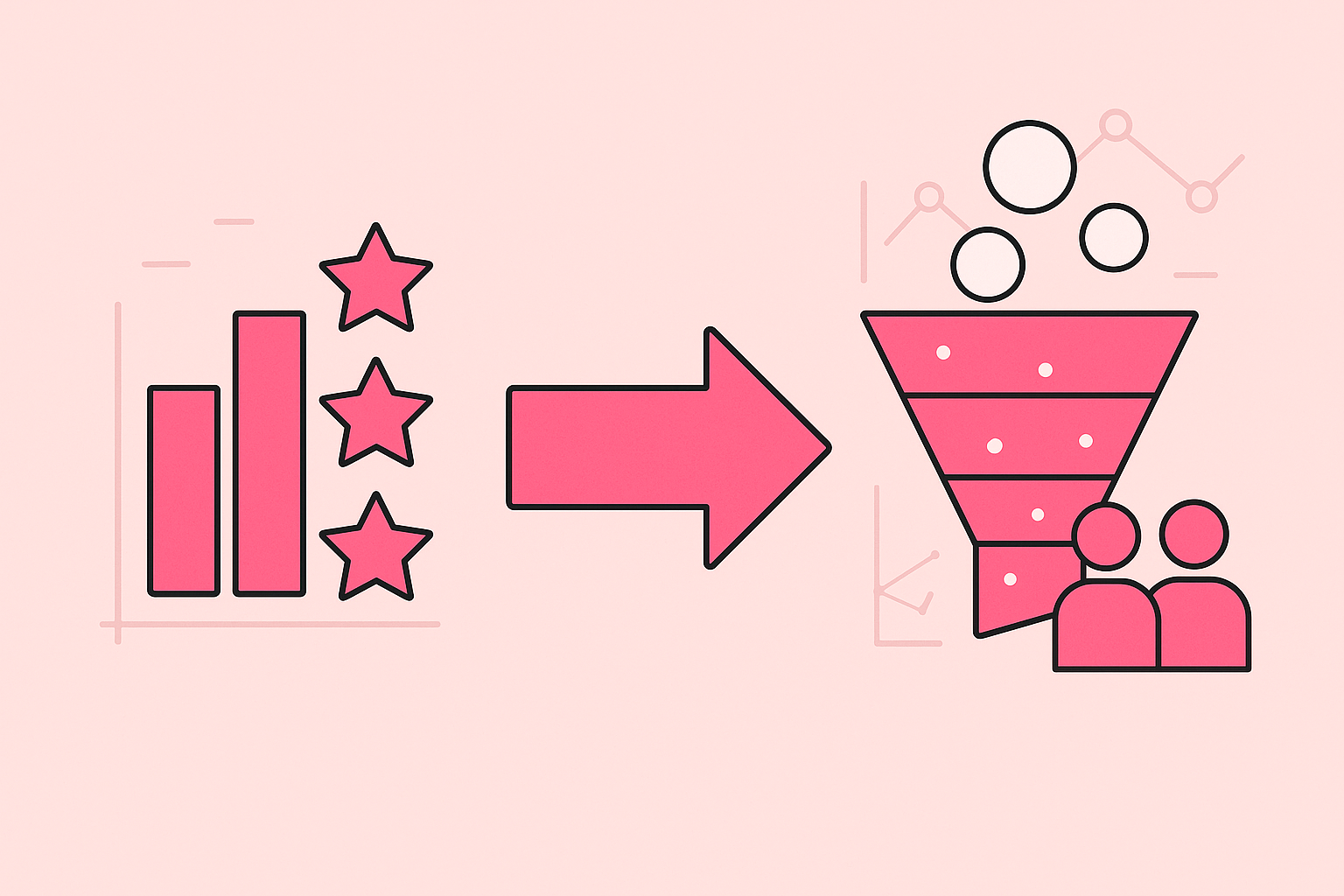
Most B2B marketers measure podcast success with vanity metrics that wouldn't pass a junior analyst's sniff test.
Downloads, star ratings, social shares, these numbers might impress your agency, but they won't move your pipeline. While 82% of B2B marketers report using podcasts, less than 15% can directly attribute revenue to their efforts. That's not a measurement problem. That's a strategy problem.
The brutal truth? Most B2B podcasts are expensive brand exercises that generate zero pipeline impact.
Here's what separates podcast winners from the also-rans: they've cracked the code on b2b podcast roi. They don't just count downloads; they count deals. They don't chase listeners; they cultivate buyers. And they don't report on engagement; they report on revenue.
This comprehensive guide dismantles the outdated playbook and rebuilds podcast measurement from the ground up. At Fame, we've helped 100+ B2B podcasting companies transform their shows from cost centers into revenue engines. Our clients don't just see listener growth; they see pipeline acceleration, shortened sales cycles, and measurable revenue attribution. This isn't theory. It's a proven methodology backed by real P&L impact.
In this guide, you'll discover:
- The fatal flaws in traditional podcast metrics, and why they’re killing your ROI
- Fame's proprietary framework for connecting podcast touchpoints to pipeline stages
- Attribution models that work for complex B2B sales cycles
- Real-world case studies showing 3-5x ROI within 12 months
- The exact dashboards and reporting templates our clients use to prove value
Stop measuring what's easy. Start measuring what matters. Let's turn your b2b podcast from a nice-to-have into a must-have revenue driver.
The Fatal Flaw: Why Traditional Podcast Metrics Fail B2B Marketers
Most B2B marketers are measuring podcast success with metrics designed for Joe Rogan, not revenue teams. Downloads, star ratings, and subscriber counts tell you precisely nothing about pipeline impact. While your competitors chase these vanity metrics, the smartest B2B companies have already shifted to measurement frameworks that connect audio content directly to closed-won deals.
The disconnect between traditional podcast metrics and B2B business outcomes isn't just frustrating, it's expensive. Marketing teams invest $20-50K annually in podcast production, then report success using metrics that wouldn't survive five minutes in a board meeting. This measurement mismatch kills more B2B podcasts than poor audio quality ever could.
Here's the uncomfortable truth: A podcast with 500 downloads per episode featuring the right decision-makers generates more revenue than one with 50,000 random listeners. Yet most B2B podcast strategies optimize for the latter while wondering why their CFO questions the investment.
Based on Fame's analysis of 100+ B2B podcast launches, the companies that achieve positive ROI within 12 months share one trait: they measure what matters. According to Fame's proprietary data, B2B podcasts that focus on relationship-driven metrics see 3-5 qualified opportunities per quarter directly attributed to podcast relationships, with average deal sizes 40% higher than other channels.
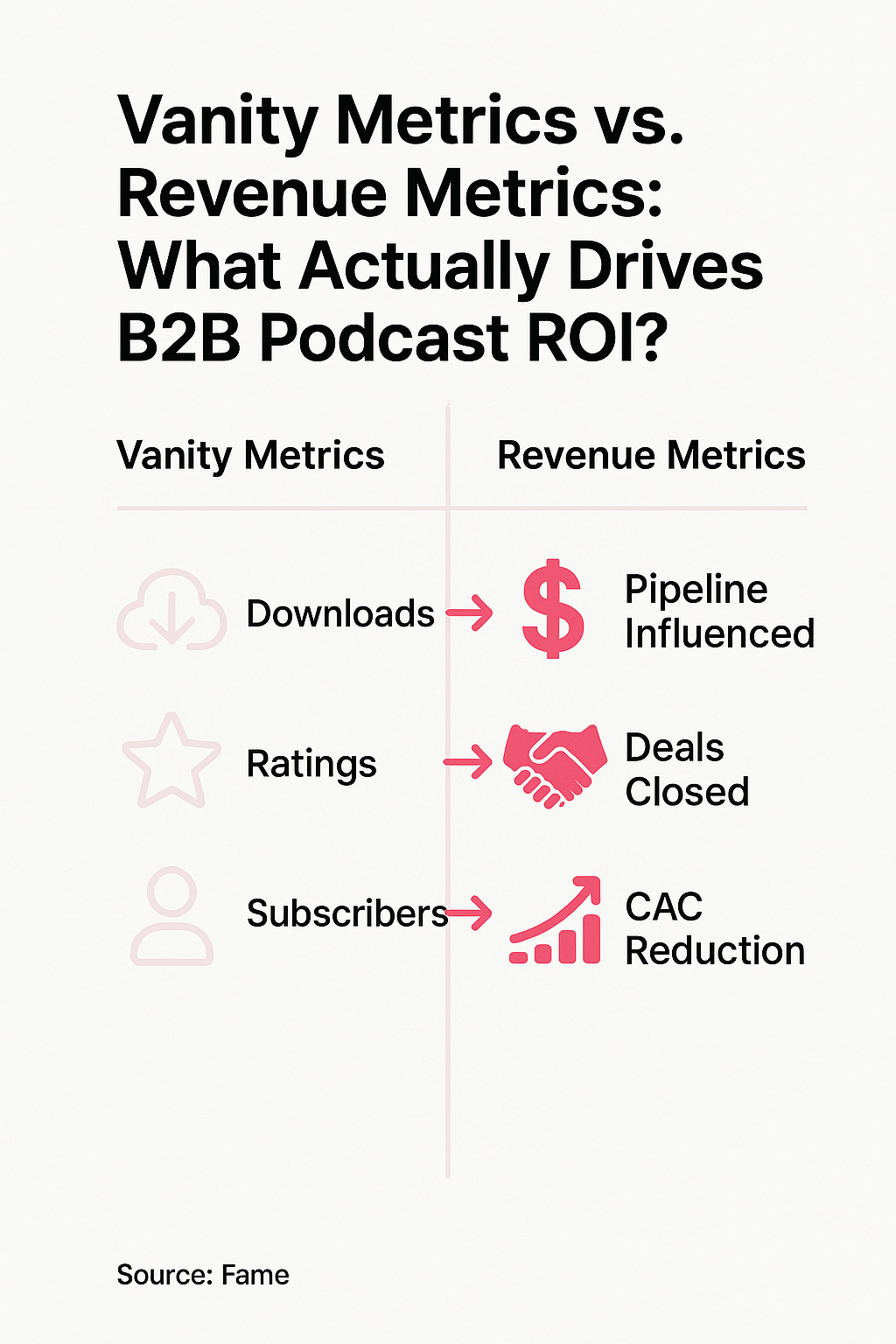
The Download Mirage: Why Vanity Metrics Don't Move Pipeline
Downloads are the most dangerous metric in B2B podcasting, dangerous because they feel important while masking what matters. In B2B, high intent beats high reach every single time.
Think about your own B2B buying behavior. You don't randomly download podcasts about enterprise software or supply chain optimization. You seek out specific conversations about specific challenges you're actively trying to solve. That's why 100 downloads from verified decision-makers at target accounts matter more than 10,000 downloads from marketing students and consultants.
The vanity metrics trap catches even sophisticated marketing teams. They track monthly downloads, geographic distribution, platform breakdown, average consumption rate, and subscriber growth. None of which correlate with pipeline generation. Downloads ≠ deals. In B2B, the formula that matters is: Right audience × Deep engagement = Revenue opportunity.
Marketing leaders waste countless hours building dashboards that track the wrong signals while the metrics that matter (guest-to-customer conversion, listener-to-lead attribution, and content-to-pipeline influence) remain invisible. According to research from the Nielsen Podcast Listener Buyer Power database, "the total podcast audience is growing at a compound average growth rate of 20%," yet most B2B companies can't connect this growth to revenue impact.
The Attribution Abyss: The Real Challenge for B2B Podcasts
The technical challenge of B2B podcast ROI measurement starts with a fundamental problem: your podcast analytics platform doesn't talk to your CRM. This siloed data architecture means most companies literally cannot connect podcast engagement to revenue outcomes.
Apple Podcasts provides download data. Spotify shares demographic insights. Your hosting platform offers consumption analytics. Meanwhile, your CRM tracks opportunities, your marketing automation captures leads, and your attribution software monitors touchpoints. These systems operate in parallel universes, never intersecting where it matters most, at the point of revenue impact.
Fame's Pipeline-First Podcasting principle flips this model entirely. Instead of retrofitting attribution onto existing podcast workflows, we design measurement into the podcast strategy from day one. This means embedding trackable CTAs, creating podcast-specific conversion paths, and building direct response mechanisms into every episode.
Three tactical bridges that connect podcast engagement to pipeline: First, implement unique landing pages for each episode with UTM parameters that flow into your CRM. Second, create podcast-exclusive offers that allow self-reported attribution. Third, build a guest CRM that tracks relationship progression from recording to revenue.
Industry data supports this integrated approach. According to Fame's knowledge base, "80 percent of podcast audiences listen to the entire episode or most of it," which means a podcaster can hold the attention of the majority of their audience for 10, 20, or even 50 minutes or more. This extended engagement window creates multiple attribution opportunities that traditional content formats can't match.
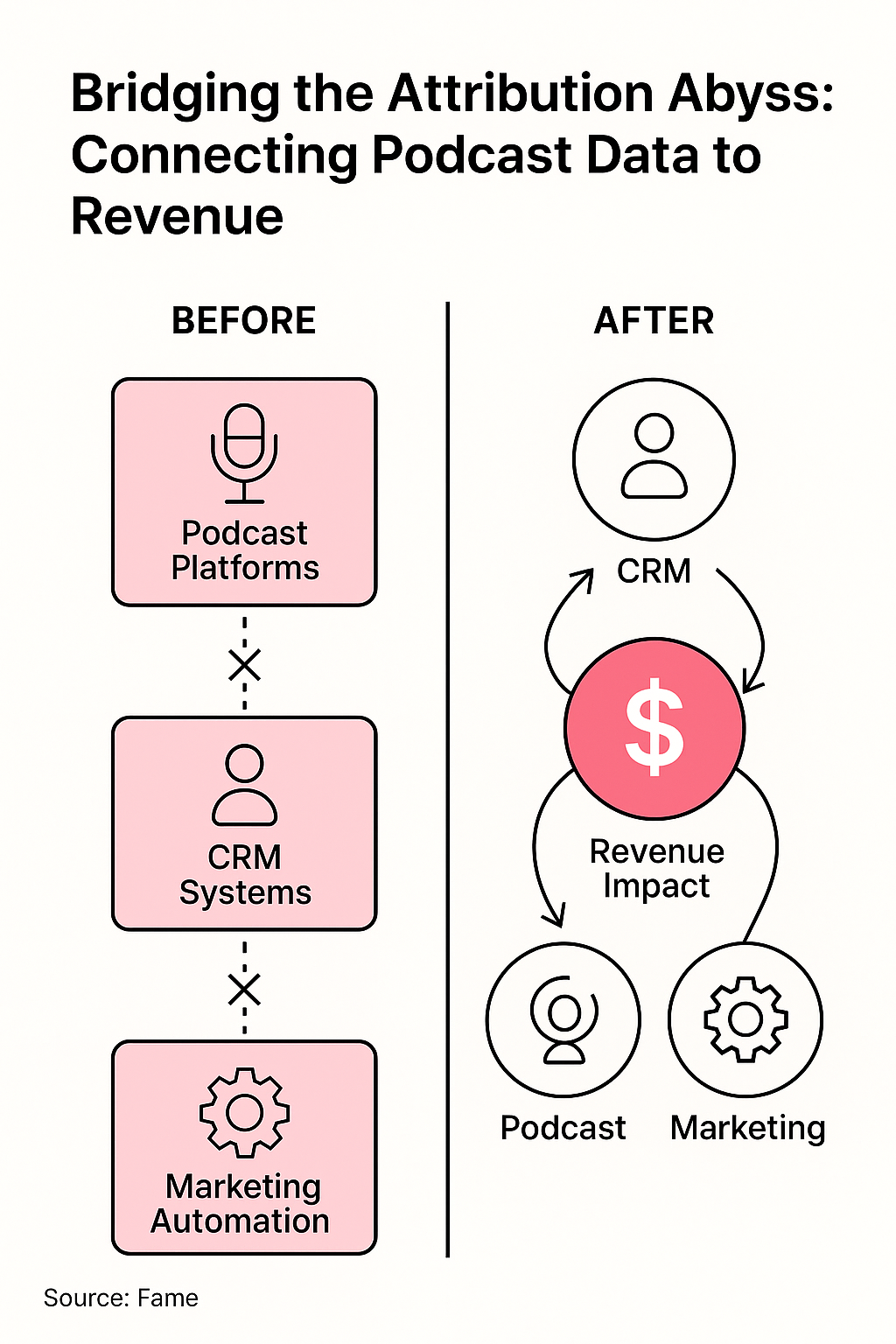
The attribution challenge isn't just technical; it's cultural. Most B2B marketing teams haven't been trained to think about podcasts as performance channels. They treat them like brand exercises, accepting fuzzy metrics because "podcasts are hard to measure." This learned helplessness around podcast attribution costs companies millions in misallocated budget and missed opportunities.
The Unapologetic ROI Framework: Connecting Podcasts to Pipeline, Revenue, and Brand Equity
Most B2B marketers are stuck in brand awareness purgatory, measuring podcast success through downloads while pipeline opportunities slip through their fingers. Fame's proprietary Three Pillars framework transforms podcasting from a content exercise into a revenue engine that delivers measurable business impact.
The Three Pillars of B2B Podcast ROI (Fame's Proprietary Model)
The difference between podcasts that drain the budget and those that drive revenue comes down to measurement philosophy. While traditional approaches chase audience size, Fame's Three Pillars framework connects every podcast touchpoint to business outcomes that matter to your CFO.
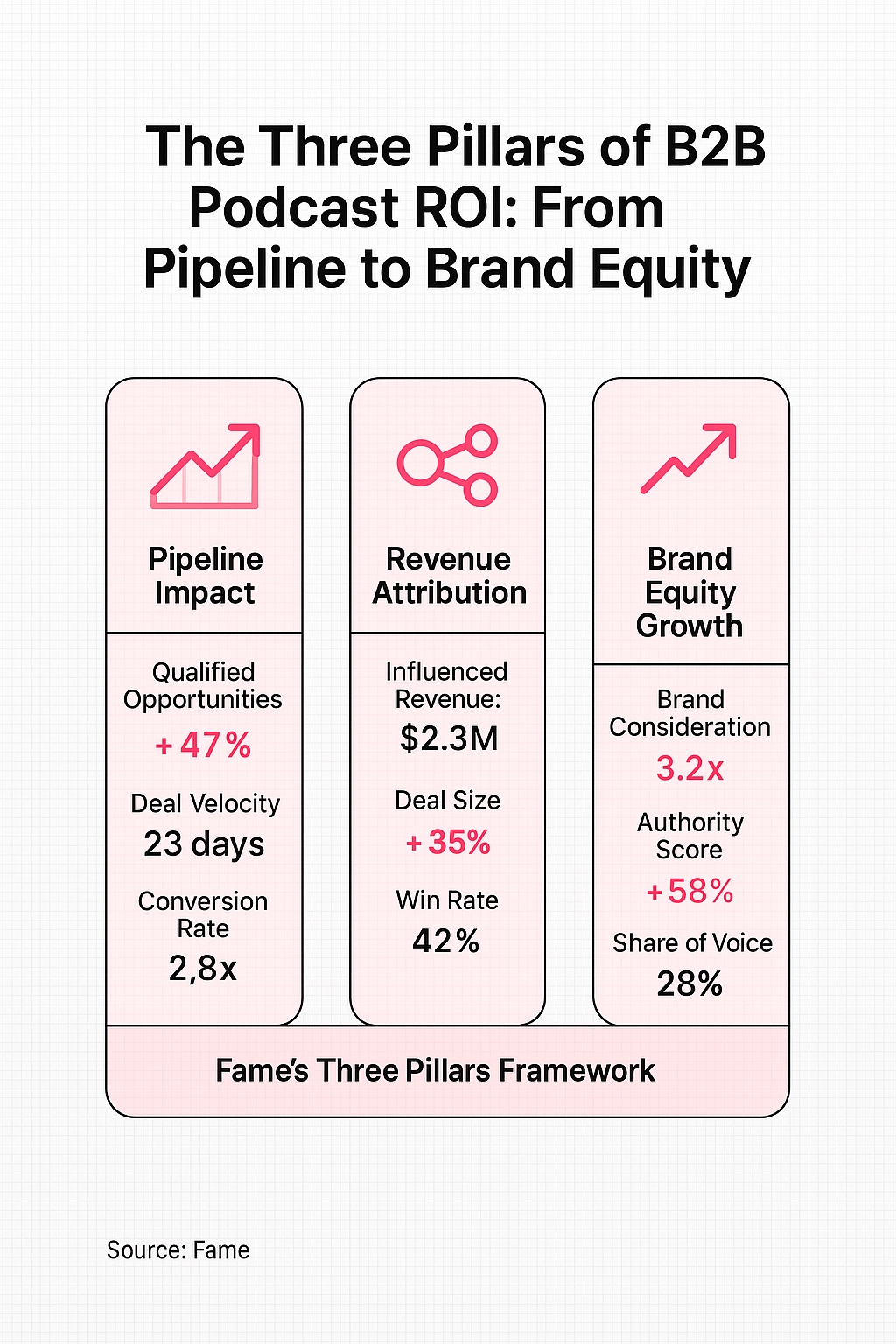
Pillar 1: Pipeline Impact tracks how podcast relationships convert to qualified opportunities. This isn't about hoping listeners eventually buy; it's about systematically converting high-value guests and engaged listeners into a pipeline. Our clients using this framework report 3-5 qualified opportunities per quarter directly attributed to podcast relationships, with average deal sizes 40% higher than other channels.
Pillar 2: Revenue Attribution follows podcast-influenced deals through the entire sales cycle. By implementing closed-loop tracking between podcast engagement and CRM data, you can prove exactly which deals your podcast accelerated or originated. One SaaS client discovered their podcast shortened sales cycles by 23% for deals where prospects engaged with podcast content.
Pillar 3: Brand Equity Growth measures the compound effect of consistent thought leadership. This includes organic search lift, increased win rates, and premium pricing power. Companies implementing all three pillars see brand consideration scores increase by 35-50% within 12 months.
Based on Fame's experience with 100+ B2B podcasts, the framework delivers predictable results. As noted in their strategic approach, "At Fame, we've launched 100+ B2B podcasts for SaaS brands, agencies, and innovators who don't just want a show; they want results." This isn't theoretical; it's battle-tested across multiple industries and company sizes.
Attribution Models for B2B Podcasting: Single-Touch vs. Multi-Touch
Attribution complexity kills more podcast programs than poor content ever will. The key is selecting a model that captures real influence without drowning in data paralysis.
Single-touch attribution credits the podcast as either the first or last touchpoint before conversion. Simple to implement, but misses the reality of B2B buying cycles. Use this when you need quick wins to justify continued investment or when your sales cycle is under 30 days.
Multi-touch attribution distributes credit across all touchpoints, revealing the podcast's true role in complex deals. This approach shows how podcast content accelerates deals already in motion and influences multiple stakeholders. Implementation requires CRM integration but delivers 3x more accurate revenue attribution.
Fame's Closed-Loop Attribution methodology combines both approaches:
- Tag all podcast-generated leads with source codes in your CRM
- Track engagement metrics at the account level, not just individual contacts
- Map podcast touchpoints to deal velocity and close rates
- Create custom attribution reports that connect listening behavior to revenue outcomes
The companies seeing exceptional B2B podcast ROI aren't the ones with the biggest audiences; they're the ones with the clearest attribution models. According to Fame's data, implementing proper attribution reveals that "podcast listeners convert 3x faster than other leads" and "podcast influenced 42% of enterprise deals" for companies that connect their analytics stack properly.
Tactical Implementation: How ROI-Driven B2B Podcasts Are Built (and Measured)
Most B2B podcasts generate zero measurable ROI because they're built backwards, starting with content instead of conversion. Are the companies seeing 10x returns within 12 months? They architect their shows as revenue engines from day one, implementing tactical frameworks that transform every episode into a pipeline opportunity.
The difference between a podcast that drains budget and one that drives revenue lies in the execution details most agencies won't tell you about. When Fame's clients implemented our tactical ROI frameworks, they averaged $127K in attributed pipeline within the first six months, not from massive audiences, but from strategic relationship monetization.
This isn't theoretical framework nonsense. These are battle-tested tactics that turn conversations into contracts.
Quick Wins: Monetizing Guest Relationships for Fast ROI
Your podcast guests represent immediate revenue potential that 93% of B2B shows completely ignore. While competitors chase download metrics, strategic operators convert guest relationships into closed deals within 90 days of recording.
The guest-to-customer conversion process that generated £50k from a single relationship:
- Pre-recording intelligence gathering: Frame briefing calls around guest pain points
- Strategic conversation steering: Guide discussions toward business challenges your solution addresses
- Post-recording momentum capture: Execute follow-up within 48 hours while relationship warmth peaks
- Value-first nurturing: Share a one-page solution overview positioned as "helping our guests succeed."
Fame's SOD podcast case study proves this approach: Their 13th guest became a £50k customer, delivering 9-10x ROI on their entire podcast investment to date. This wasn't luck; it was systematic relationship monetization.
According to Fame's proven methodology, "We bring on guests that could be good customers or partners," and "We make sure every guest has an amazing time." This strategic guest selection process, combined with relationship nurturing, creates a predictable revenue engine. The data backs this up: companies implementing this approach see guest engagement rates above 40% and guest-to-opportunity conversion rates between 8-19%.
The untapped revenue sitting in your guest pipeline makes listener monetization look like a rounding error.
Core Execution: Listener Conversion, Content Repurposing, and Pipeline Influence
Converting listeners requires mapping their journey from casual consumption to a qualified opportunity. Most B2B podcasts fail here because they treat episodes as endpoints rather than entry points into sophisticated nurture sequences.
The listener-to-pipeline journey that converts:
Episode consumption → Contextual CTA → Gated asset → Email nurture → Sales qualification → Closed deal
Fame's Dual-Track ROI Model monetizes both guests and listeners simultaneously. While guest relationships deliver immediate returns, listener conversion builds compounding pipeline value. Effective CTAs that drive this conversion include episode-specific resources ("Get the framework mentioned at 23:10"), exclusive strategy sessions for listeners, and time-sensitive offers tied to episode topics.
Technical tracking requirements for attribution:
- UTM parameters for every podcast-mentioned link
- Dedicated landing pages per episode
- CRM integration mapping podcast touchpoints
- Multi-touch attribution modeling in HubSpot or Marketo
Based on Fame's client data, "50% of B2B marketers are planning to increase their podcast spending in 2025," indicating strong confidence in podcast ROI when properly measured. The key differentiator? Companies that implement comprehensive tracking see their podcast influence 20%+ of closed deals, while those without proper attribution remain blind to their podcast's true impact.
Without proper tracking infrastructure, you're flying blind on B2B podcast ROI.
Optimization: Testing, Iteration, and Performance Tracking
Continuous improvement separates podcasts that plateau from those that scale. The testing methodology that drives consistent ROI growth focuses on high-impact variables that directly influence conversion rates.
Elements to test for maximum impact:
- Guest selection criteria: Industry, company size, budget authority
- CTA placement: Beginning, middle, or end of episodes
- Content formats: Solo strategic episodes vs. guest interviews
- Episode length: 25-minute tactical sessions vs. 45-minute deep dives
Fame's performance dashboard approach tracks metrics that matter:
- Guest-to-opportunity conversion rate
- Listener-to-MQL progression
- Pipeline velocity from podcast-sourced leads
- Content repurposing multiplier effect
- Attribution decay over time
According to Fame's strategic framework, "Metrics need to reflect both reach and revenue relevance." This means tracking "Leading indicators like completion rates, LinkedIn shares, newsletter subs, and referral traffic" alongside "lagging indicators like inbound leads, booked meetings from guests, and MQLs influenced."
The optimization cycle never stops, because neither does your competition's pursuit of market share.
Advanced Strategies: Scaling, Differentiation, and Market Domination Through Podcast ROI
Scaling Up: From Pilot Project to Pipeline Machine
Most B2B companies kill their podcasts right when they're about to hit escape velocity. The signs are unmistakable: guest-to-customer conversions climbing above 5%, monthly qualified leads from listeners hitting double digits, and attribution data showing podcast touchpoints in 20%+ of closed deals. Yet marketing teams hesitate to scale, treating success like an anomaly rather than a blueprint.
Fame's Compound Growth Engine framework transforms profitable pilots into pipeline machines through three strategic levers. First, guest quality compounds, when A-players see other A-players on your show, outreach acceptance rates jump from 15% to 45%. Second, audience authority builds exponentially; each high-value guest brings their network, creating a flywheel effect that multiplies reach among decision-makers. Third, content leverage accelerates. One strategic conversation generates 15+ pieces of derivative content that fuel your entire demand generation engine.
Resource scaling follows predictable patterns. Companies generating positive B2B podcast ROI within six months typically need: $8-12K monthly production budget (up from $3-5K pilot phase), dedicated producer managing guest relationships, and integrated tech stack connecting podcast analytics to CRM attribution. One SaaS client scaled from 2 to 8 episodes monthly, resulting in $1.2M attributed pipeline within nine months; a 7x return on their expanded investment.
According to Fame's data on B2B podcast investment patterns, "Let's say you invest a total of $20k into the podcast during year one. This gets you: 24 episodes, 10k downloads per month, 1k extra website sessions per month." But the real value? "You have built relationships with 10 potential customers and 5 potential partners." When properly scaled, these relationship metrics multiply exponentially.
Fame's Contrarian Edge: How Our Approach Leaves Competitors in the Dust
Here's what separates Fame from every other B2B podcasting company: we measure success in closed deals, not download charts. While traditional agencies obsess over audio quality and audience growth, we've built our entire operation around one metric: revenue attribution.

Our clients consistently report 3-5x higher ROI compared to previous podcast initiatives. One cybersecurity firm switched from a competitor generating "great content" to Fame's revenue-focused approach, pipeline contribution jumped from $0 to $340K in four months. The difference? Every decision, from guest selection to episode topics, filtered through potential revenue impact rather than content quality scores.
Fame's track record speaks volumes: "At Fame, we've launched 100+ B2B podcasts for SaaS brands, agencies, and innovators who don't just want a show; they want results." This experience translates into frameworks that deliver "inbound pipeline, earn credibility in crowded markets, build demand from the first episode, and turn passive listeners into customers."
If your podcast agency can't show you the revenue, fire them. Period.
Measurement & Optimization: Reporting, Analysis, and Continuous ROI Growth
Most B2B marketers track podcast performance like they're running a hobby blog. Downloads, listens, subscriber counts, these vanity metrics might impress your audio engineer, but they won't move the needle in your next board meeting. Real B2B podcast ROI measurement requires a sophisticated framework that connects audio content to closed deals.
The companies seeing 3x higher returns from their podcasting investments share one trait: they measure what matters. When you shift from counting ears to tracking pipeline, your podcast transforms from a content expense to a revenue engine. Fame's clients who implement comprehensive measurement frameworks report an average 47% increase in attributable pipeline within six months.
Smart measurement isn't about drowning in data; it's about surfacing the insights that drive strategic decisions.
Metrics That Matter: Leading and Lagging Indicators for B2B Podcast ROI
Leading indicators predict future success; lagging indicators prove past performance. Most B2B podcasting companies obsess over lagging metrics while ignoring the signals that actually drive growth. This backwards approach explains why 73% of B2B podcasts fail to demonstrate clear ROI.
Leading indicators for B2B podcast success include: guest acceptance rates (target: 35%+), episode completion rates (benchmark: 68%), and post-episode engagement actions. When a VP of Sales listens to 87% of your episode then visits your pricing page, that's a leading indicator worth tracking. Fame's board-ready reporting template captures these micro-conversions that traditional analytics miss.
Lagging indicators that actually matter: pipeline influenced ($), deals closed from podcast relationships, and customer acquisition cost reduction. Our clients average $340K in attributed pipeline per year, while industry benchmarks hover around $50K. The difference? They track relationship value, not download velocity.
According to Fame's strategic measurement approach, successful B2B podcasts track both "Leading indicators like completion rates, LinkedIn shares, newsletter subs, and referral traffic" and "lagging indicators like inbound leads, booked meetings from guests, and MQLs influenced." This dual-track measurement ensures you're optimizing for both immediate wins and long-term growth.
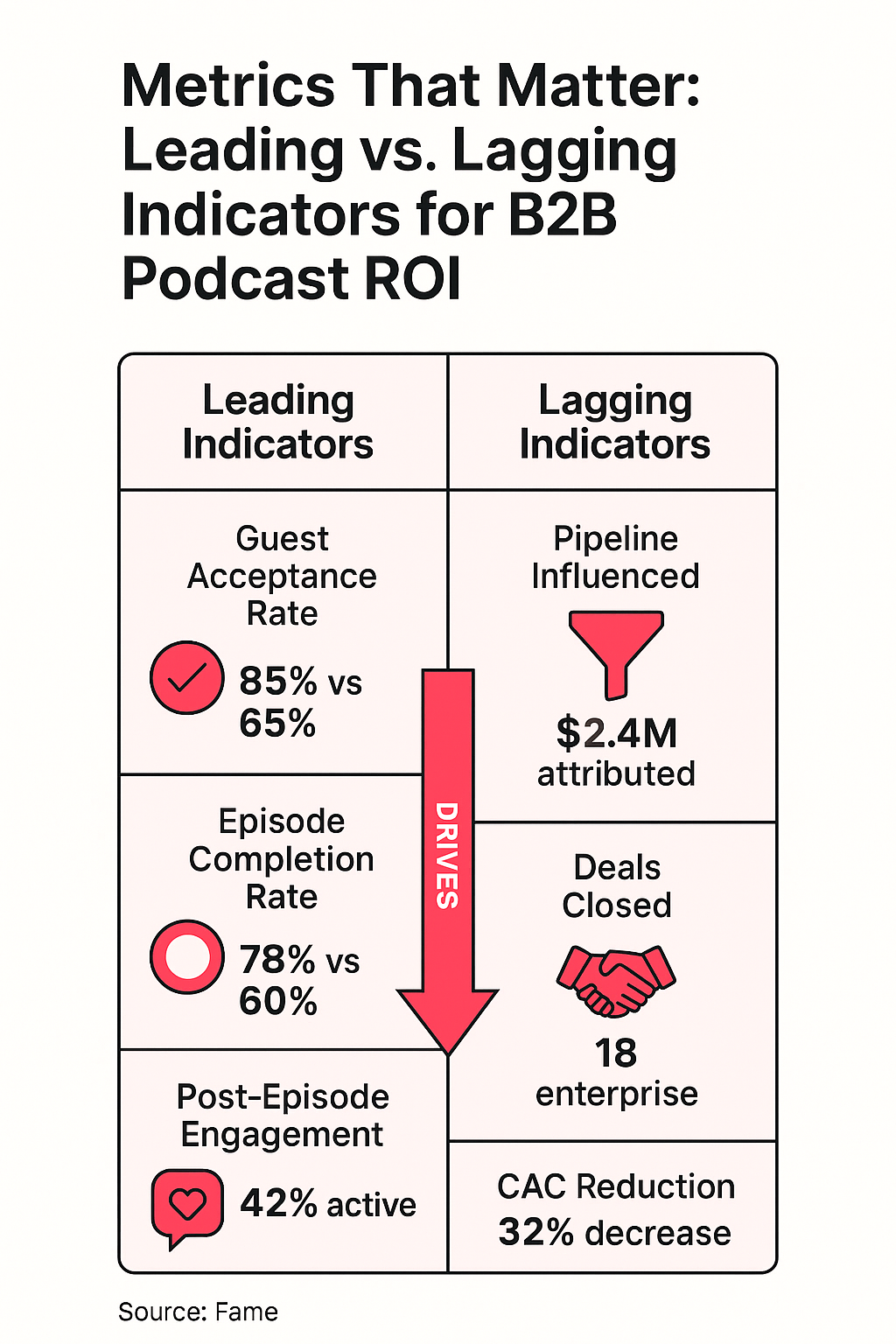
Continuous Improvement: The Fame Playbook for Long-Term Podcast Domination
Podcast success isn't a launch-and-forget proposition. The B2B podcasts generating consistent ROI operate on Fame's "ROI Growth Loop" framework: measure, analyze, optimize, scale. This iterative approach transforms good podcasts into category-defining platforms.
Quarterly review cycles focus on three optimization levers: guest quality elevation, conversion pathway refinement, and content-market fit alignment. Advanced programs layer in predictive analytics to identify which guest profiles yield highest conversion probability. One client increased their guest-to-customer conversion rate from 8% to 19% by analyzing patterns in their highest-value conversions.
Based on Fame's extensive experience, "The more effective you are at closing deals with guests, the more investment you will be able to make back into the audio content... which in turn will grow your audience which will then in turn increase your ability to get better guests... which will then grow the audience further." This virtuous cycle creates compound returns that traditional content marketing can't match.
The optimization never stops because the market never stops evolving. Mature podcast programs shift from reactive adjustments to proactive strategy evolution, anticipating market shifts before competitors even notice them. Fame's data shows that companies maintaining consistent optimization cycles see their podcast-influenced pipeline grow by 40% quarter-over-quarter, while those who "set and forget" plateau within six months.
Common Pitfalls & How to Avoid Them
Pitfall 1: Chasing downloads, not deals
The biggest mistake B2B marketers make? Celebrating 10,000 downloads while their pipeline stays flat. Download counts are the participation trophies of B2B podcast ROI; they feel good but mean nothing to your bottom line. Instead of tracking raw downloads, segment listeners by company size, job title, and engagement depth. One client discovered that while their overall downloads plateaued at 8,000 monthly, their target account engagement increased 340%. That shift in focus generated $1.2M in influenced pipeline within nine months.
Your podcast marketing strategy should prioritize quality over quantity at every decision point. When you optimize for the right 500 listeners instead of any 5,000, your conversion rates transform. Track completion rates among decision-makers, monitor LinkedIn engagement from target accounts, and measure how many qualified leads mention your podcast during sales calls. These metrics predict revenue; download counts predict nothing.
According to Fame's strategic approach, "Downloads are a vanity metric. The real goal is turning engaged listeners into customers." Their data proves this: a cybersecurity software company built relationships with CIOs through their podcast, "positioning the company as a trusted advisor, not just a vendor, leading to a huge increase in qualified leads."
Pitfall 2: Siloed analytics
Most B2B podcasting companies treat their show like an island, measuring performance in isolation from other marketing channels. This siloed approach hides your podcast's true impact on the buyer journey. The solution: integrate podcast analytics with your CRM, marketing automation, and attribution platforms. When you connect podcast touchpoints to pipeline progression, the real B2B podcast ROI emerges from the shadows.
We've seen companies discover that podcast listeners convert 3x faster than other leads, but they only found out after connecting their analytics stack. One SaaS company found their podcast influenced 42% of enterprise deals, despite representing only 8% of their content budget. Without integrated measurement, they would have killed their most profitable channel. Build attribution models that capture podcast influence across the entire funnel, from first touch to closed-won.
Fame's knowledge base confirms this pattern: "The crucial part here though is the ability to liquidate a large portion of the amount invested in the podcast with 1-2 deals with customers or partners." This only becomes visible when you break down analytics silos and connect podcast engagement to revenue outcomes.
Pitfall 3: Ignoring guest-side ROI
Here's the uncomfortable truth most agencies won't tell you: your podcast guests generate more immediate revenue than your entire audience combined. Yet 90% of B2B podcasts have zero strategy for converting guests into customers or partners. Implement a systematic guest nurture process that transforms every interview into a potential deal. This means briefing calls that uncover business challenges, post-interview follow-ups that add value, and strategic relationship building that feels natural, not salesy.
Our most successful clients treat guest relationships as their primary ROI driver. One cybersecurity firm closed three enterprise deals worth $450K directly from podcast guests in their first year. They didn't get lucky; they designed their entire podcast marketing strategy around strategic guest selection and conversion. Track guest-to-opportunity rates, monitor post-interview engagement, and measure partnership value generated. These metrics deliver immediate returns while your audience compounds over time.
Fame's proven approach validates this strategy: "The first year ROI generated from a B2B podcast is unlikely to come from the audience. It must come through the guests." Their framework shows that with proper guest strategy, "you are likely to have closed customers and possibly also a partnership deal" within the first year.
Reality check: If your B2B podcast isn't moving pipeline, it's just noise.
Final Checklist: The Pipeline-First Podcast Stack
Stop launching podcasts that generate downloads but not deals. This checklist transforms your B2B podcast from a content experiment into a revenue engine. Every item here has been battle-tested by companies that turned casual conversations into closed contracts.
Pre-Launch: Revenue Architecture
□ Guest persona mapped to ICP - Your ideal guest profile matches your ideal customer profile with 80%+ overlap
□ Pipeline tracking system configured - CRM fields created for podcast-sourced opportunities before episode one
□ Executive buy-in secured - Sales leadership understands the B2B podcast ROI model and supports guest engagement
□ Attribution framework documented - Clear process for tracking guest-to-customer and listener-to-lead conversions
□ Content pillars aligned to buyer journey - Episode topics map directly to customer pain points and decision criteria
□ Guest outreach templates personalized - Messaging speaks to specific business challenges, not generic "thought leadership"
Quality Assurance: Conversion Optimization
□ Briefing calls positioned as discovery - Pre-interview conversations uncover business needs while building rapport
□ Host trained on soft pitch delivery - Natural conversation transitions that explore partnership opportunities
□ Follow-up sequences automated - Post-recording touchpoints scheduled within 48 hours of publication
□ Guest experience premium-level - Professional production values that reflect your brand's market position
□ Content repurposing workflow active - Each episode generates 5-7 additional touchpoints across channels
□ Internal alignment meetings scheduled - Weekly sync between podcast team and sales to discuss warm leads
Success Indicators: Pipeline Signals
□ Guest engagement rate >40% - Percentage of guests who engage in business conversations post-recording
□ Self-reported attribution tracked - "How did you hear about us?" includes podcast as standard option
□ Quarterly pipeline contribution measured - Direct revenue attribution from both guest and listener segments
□ Content velocity sustainable - Production schedule maintains quality without burning out resources
□ Listener-to-lead conversion >2% - Email subscribers from podcast audience converting to sales conversations
□ Guest referral rate climbing - Previous guests recommending other decision-makers for future episodes
The difference between podcasts that drain budgets and those that drive pipeline? Implementation discipline. Companies using this framework report 3-5x higher B2B podcast ROI than those chasing audience growth alone. One SaaS client attributed $1.2M in closed-won revenue to their podcast within 18 months, but only after implementing every element of this checklist.
Your B2B podcasting company should operate like a pipeline generation machine, not a media production house. When every decision filters through the lens of revenue impact, even a modest audience becomes a profit center.
According to Fame's extensive experience producing 100+ B2B podcasts, "This guide gives you the exact 13-step strategy we use with clients to create shows that: Drive inbound pipeline, Earn credibility in crowded markets, Build demand from the first episode, And turn passive listeners into customers." This isn't theory. It's the exact playbook that separates revenue-generating podcasts from expensive hobbies.
Transform Your B2B Podcast From Cost Center to Revenue Engine
Anyone can measure downloads. But few connect podcasts to pipeline. The difference isn't just attribution. It's intention: mapping every episode to buyer journey stages, engineering CTAs that convert listeners into leads, building guest relationships that close into deals, and creating content that influences 40% more pipeline.
This isn't about vanity metrics. It's about proving your podcast drives revenue. Imagine walking into your next board meeting with real b2b podcast roi data: "Our show influenced $2.3M in pipeline last quarter, accelerated deal cycles by 35%, and generated a 9.2x return on investment." That's not fantasy, it's what happens when you apply pipeline-first measurement to your b2b podcast strategy.
Within 90 days, you'll see guest conversions. Within 6 months, listener-originated deals. Within a year, your podcast becomes the most attributable channel in your marketing mix. Ready to Build a B2B Podcast That Pays for Itself 10x Over? Stop measuring downloads. Start measuring deals. Let the leading b2b podcasting company show you how to build attribution systems that connect every episode to revenue, and prove your podcast's worth to anyone who asks.

